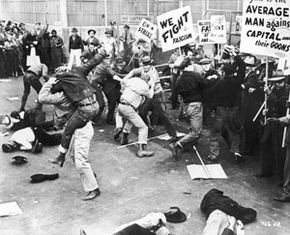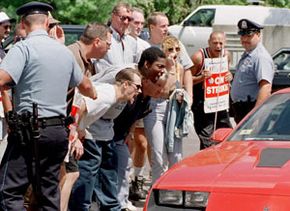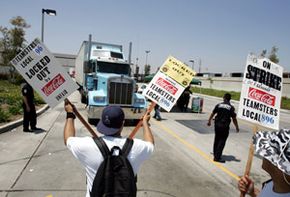In 1892, there was a series of famous strikes in the United States -- a general strike in New Orleans, a copper miners' strike in Idaho and a coal miners' strike in Tennessee -- but none became as famous as the Homestead Strike against Andrew Carnegie's steel empire in Pennsylvania [source: PBS].
Carnegie's plant manager, Henry Frick, wanted to break the steel workers' union by slashing wages, provoking a strike and bringing in scab labor. Things didn't go quite as planned. Not only did the workers go on strike, but they physically occupied the steel plant, shielding it from scab workers. Frick called in hired guns called Pinkerton detectives to crush the rebellion.
On the night of July 5, 1892, barges carrying hundreds of armed Pinkerton detectives floated up the river toward the Homestead plant. The Pinkertons were met with violent resistance. By the end of the 14-hour gunfight, three detectives and nine workers were dead [source: PBS]. Frick called in military support from the governor and trucked in scab labor. The steel worker's union eventually gave in to Frick's demands, which sapped the power from steel unions for decades.
Andrew Carnegie never recovered from the tragic events at Homestead, saying later, "…but the false step was made in trying to run the Homestead Works with new men. It is a test to which workingmen should not be subjected. It is expecting too much of poor men to stand by and see their work taken by others."
Some of the largest and longest strikes in history were eventually undermined by scab labor. In the early 1890s, several of Australia's major unions, including those representing miners, maritime laborers and wool shearers, went on strike for higher wages, fairer treatment and the right to organize [source: Armstrong].
The bosses brought in scab labor -- which was plentiful due to widespread unemployment -- and there were many violent clashes between striking workers and their replacements. The maritime strike broke under the weight of the scab labor, and the shearers' strike escalated to armed confrontations and dragged on for years before finally failing as well.
The Herrin Massacre is one of history's most notorious scab labor tragedies. On June 22, 1922, in the town of Herrin, Ill., striking coal miners surrounded a mine full of nonunion scabs. Armed with rifles and farm implements, the strikers promised that if the scabs surrendered, they would be escorted safely out of town. Instead, the scabs were marched through Herrin and into the woods, where 20 of them were murdered and others seriously injured [source: Encyclopedia Britannica]. A jury acquitted all the strikers of wrongdoing.
In the next two sections, we'll look at the negatives and also the positives of scab labor.





